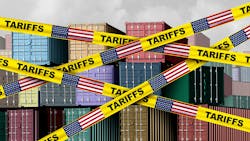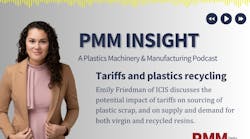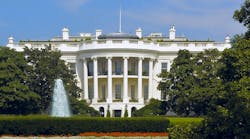Could Trump tariffs help or hurt plastics businesses?
By Karen Hanna, Bruce Geiselman and Lynne Sherwin
As the potential for tariffs ripples throughout the manufacturing world, consultants and plastics industry leaders are weighing the possibility of reshoring against the risks of rising costs and supply chain complications.
A statement from Germany-based Arburg GmbH + Co KG — which has branches in Rocky Hill, Conn., and Querétaro, Mexico — relayed some of the industry's ambivalence about the situation.
In a statement sent to Plastics Machinery & Manufacturing on Feb. 13, more than a week after President Trump first announced, then paused, tariffs on goods from Mexico and Canada, Michael Hehl, managing partner of the Arburg Management Board, said, "The situation regarding the new U.S. customs policy and its impact on the plastics industry is still unclear for us at present. ...
"We generally fear that tariffs could lead to our products becoming more expensive and thus undermine our competitive advantages over products with lower quality and technological performance. In addition, time-consuming customs clearance in ports of entry could jeopardize our reputation for on-time delivery. ..."
Recent news has had industry watchers and economists on alert for signs of a widening trade war.
On Feb. 3, Trump — who has used security concerns to justify sidestepping the United States-Mexico-Canada Agreement he negotiated in his first term — announced that 25 percent tariffs against Mexico and Canada had been paused for one month. Meanwhile, in retaliation against his decision to impose additional 10 percent tariffs on goods from China, Beijing announced its own tariff package. On Feb. 10, Trump announced further tariffs — 25 percent on all steel and aluminum entering the U.S.
Harry Moser, the founder and president of the Reshoring Initiative, a Sarasota, Fla.-based organization dedicated to moving manufacturing jobs back to the U.S., summed up the impact succinctly: “Will help companies that produce and source mostly domestically. Will be a problem for those with significant import dependence.”
While Moser voiced support for protectionist trade measures, other manufacturing leaders expressed alarm at the back-and-forth triggered when Trump first announced he planned to hit Mexico and Canada with tariffs.
“My first reaction was, why did the President choose to throw a grenade into the auto industry? And does he understand what he’s done by implementing 25 percent on Mexico and Canada and not so much — 10 percent — on China? I think [the China tariff] is just a warning shot [in] the early days,” said Jan Griffiths, who as the founder of Gravitas Detroit provides consulting to Tier 1 suppliers in the automotive industry. “But does he understand how complex our supply chains are in the automotive industry, and the ramifications of such a harsh increase coming through with no warning?”
Laurie Harbour, a partner at Wipfli LLP and longtime consultant to molding and mold making shops, saw both positives and negatives in the measures.
“There are certain areas where I think the tariffs are good, and there are certain areas where they’re not so good,” she said. “My biggest question in my head is, why only 10 percent on China, when that’s probably our biggest enemy ...[in terms of] losing jobs? ... We’ve lost more jobs to China than we than we have to Canada.”
“It’s one mechanism to use to go after the goals he’s trying to achieve. I’m just not convinced it’s the best, and I believe it’s going to raise costs in many areas,” Harbour said.
View from manufacturers
Trade groups were largely critical of the tariffs, but manufacturers’ views were mixed.
For example, in anticipation of the since-paused tariffs on Mexico and Canada, the Plastics Industry Association (PLASTICS) said, “While we understand President Trump’s rationale, a blanket tariff policy could have significant economic consequences, disrupting the movement of essential machines, products, and materials that keep American manufacturers running. A competitive industry requires policies that protect high-quality jobs and ensure stable supply chains across sectors like healthcare, consumer products, and automotive.”
In recent years, in the wake of multiple pandemic-era supply chain crises, several machinery OEMs have built manufacturing facilities in Mexico to shorten the supply chain and in hopes of avoiding tariffs. Since Trump’s election in November, manufacturers of plastics machinery have expressed conflicting views about whether tariffs would help or hurt, depending, in part, on where they’re based.
On Feb. 3, Jeff Ignatowski, president of Auburn Hills, Mich., injection molder Champion Plastics Inc., joined Moser in expressing his hopes about the situation. He also sits on the board of directors of the Manufacturers Association for Plastic Processors.
Noting that his plant buys its molds from China at a 25 percent markup, he said viewed Trump’s threats of tariffs as “mostly posturing” and, in the hours before the tariffs on Mexico and Canada were paused, he predicted they would be only short-term.
“We currently employ [about] 25 people (we are highly automated) and as mentioned, overall, I’m actually optimistic the tariffs will have a positive effect on Champion and will lead to new hires and more CAPEX investments,” he wrote in an email.
Two companies watching the news from Ontario, Canada, which had threatened retaliatory tariffs before the one-month reprieve, were StackTeck, based in Brampton, and Proco Machinery Inc., based in Mississauga.
Jordan Robertson, VP of business development and marketing for StackTeck, said business recently has been good, but the tumult over tariffs could hurt.
With 270 employees in Canada, StackTeck supplies injection molds and automation for closures, packaging, medical and PET preform applications. It relies on many U.S. suppliers, and about half of its business comes from U.S. customers.
“We believe that the uncertainty of the situation has already affected the confidence levels of business in general,” Robertson said.
Proco company President John McCormick, who called the volley of tariff threats between borders, “a rollercoaster ride,” predicted the automation equipment maker could weather U.S. tariffs if they are applied against Canadian goods.
Whatever ultimately happens with tariffs, McCormick said he believes U.S. customers would still turn to Proco when they need parts or service for existing equipment.
“I’m absolutely sure they will,” he said. “Trust me, if a machine’s down, they will. They want those parts. We’ve been supplying the blow molding industry for 40 years, and we have thousands of pieces of equipment out there that need parts and service. Those parts are unique and only available from Proco.”
He expressed confidence Proco could replace whatever U.S. business it might lose with sales in other markets, but warned other Canadian companies, especially plastics processors with razor-thin margins, could be forced to lay off workers if tariffs come to fruition.
“I don’t know how a plastics processor can ship parts to the U.S. and survive with the 25 percent tariff,” he said. “I think that’s going to be devastating. And on the other end, U.S. companies that sell into Canada facing a 25 percent tariff will have the same effect. So, on both sides of the border, I anticipate layoffs for certain businesses but not my business. I will replace that business with business from Canada, Mexico and the rest of the world. And with certain products, I will be more competitive than the U.S. counterparts.”
In addition to PLASTICS, the proposed tariffs also drew fire from the National Association of Manufacturers, MEMA, the Vehicle Suppliers Association, the Consumer Brands Association and other organizations and analysts, according to according to IndustryWeek, which like Plastics Machinery & Manufacturing is an Endeavor Business Media publication.
The big picture
Assessing the full effect of potential tariffs is difficult, because companies’ individual situations and supply chains differ. For consultants Griffiths and Harbour, one question to keep in mind is: Who picks up the tab, and how is the cost of tariffs distributed along the supply chain?
Also uncertain is how long any tariffs instituted now or in the future might last. While the long-term effects could be significant, several of the industry leaders predicted a standoff with Mexico and Canada would be only temporary.
“The biggest concern, of course, is who pays this tariff,” Griffiths said. “We all know that in the manufacturing world, certainly plastic injection molders are not going to have that kind of margin to just absorb a 25 percent tariff. ... Some of the OEMs have already signaled — and I have to be careful what words I use here — have already signaled an indication of sharing the pain, which loosely translated, means we’re going to be forcing the supply base to absorb a huge chunk of it.”
That creates tension among suppliers and manufacturers up and down the supply chain, she said.
One complication worrying both Griffiths and Ignatowski is the movement of goods that travel back and forth across borders multiple times.
Ultimately, they predicted that in the automotive supply chain, it would be vehicle buyers who foot the bill.
“I think the biggest issue will be the vast number of larger parts and assemblies that ship back from China and back and forth between Canada and Mexico. The supply chain and the OEMs can’t absorb compounded tariffs which will quickly erode margins and will eventually lead to higher car prices for consumers,” Ignatowski said.
As Perc Pineda, chief economist for PLASTICS, observed before Trump’s inauguration, managing tariffs is a bit of a balancing act between protecting American workers and maintaining market access. He warned at the time about the potential for supply chain disruption.
“If, in fact, we have tariffs that are very high and prohibitive, then we would have some short-term volatility in the market, if we can’t get the inputs to production. But if we’re serious about reviving domestic manufacturing, then I think the right trade policy would be to provide some carve-outs for those things that we need to make things here, and that includes all this equipment for plastics, some of which we don't make in the United States anymore, and some materials that go into it we don’t make anymore,” Pineda said.
If tariffs are applied, and they remain in effect for the long term, Harbour said she believes they could result in reshoring. But the flurry of Monday’s tariff announcements and postponements presented a “moving target” for drawing any conclusions.
“I don’t know how well this sticks long term, but if it does seem to stick long term, then you’re going to see reshoring into the U.S. for sure,” she said. “You’re going to see some products that are currently made in Mexico that might get shifted back to the U.S. plant. And it’s not going to stop the growth in Mexico, because a lot of growth in Mexico stays in Mexico.”
Tooling capacity — long a concern for Harbour — doesn’t exist in the U.S to pick up all the work, she said.
Though bullish on tariffs, Moser conceded efforts to bring parity to the trade deficit would take a long time, and require price increases.
In an email addressing the additional 10 percent tariffs on China and proposed 25 percent tariffs on Canada and Mexico, he offered this assessment: “Expect the U.S. trade deficit to shrink, domestic production to increase. Trump’s target should be to eliminate the trade deficit, increasing U.S. [manufacturing] by 40 percent. Will require a huge investment in recruiting and training skilled workforce, equipment and buildings. Will take decades.”
Related content
About the Author
Karen Hanna
Senior Staff Reporter
Senior Staff Reporter Karen Hanna covers injection molding, molds and tooling, processors, workforce and other topics, and writes features including In Other Words and Problem Solved for Plastics Machinery & Manufacturing, Plastics Recycling and The Journal of Blow Molding. She has more than 15 years of experience in daily and magazine journalism.
Bruce Geiselman
Senior Staff Reporter Bruce Geiselman covers extrusion, blow molding, additive manufacturing, automation and end markets including automotive and packaging. He also writes features, including In Other Words and Problem Solved, for Plastics Machinery & Manufacturing, Plastics Recycling and The Journal of Blow Molding. He has extensive experience in daily and magazine journalism.
Lynne Sherwin
Managing Editor
Managing editor Lynne Sherwin handles day-to-day operations and coordinates production of Plastics Machinery & Manufacturing’s print magazine, website and social media presence, as well as Plastics Recycling and The Journal of Blow Molding. She also writes features, including the annual machinery buying survey. She has more than 30 years of experience in daily and magazine journalism.






